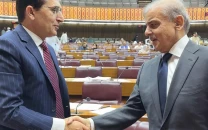Revenue failure not an NFC problem
Provinces need fairer revenue distribution, stronger capacity to generate income

The National Finance Commission (NFC) award, which provides the constitutional framework for allocating the federal government's tax revenue to the provinces for managing their annual expenses, is in the news nowadays. The allocations are made from a predefined divisible pool of taxes and duties levied and collected by the federal government.
In this regard, blaming the current share (42.5%) of the federal government in the formula for the ever-increasing debt trap has been a popular theme among many in the federal elite. They want it to be increased. This implies that the provinces are overspending. However, the increasing poverty, with 45% of people already below the poverty line, ie, their daily per capita income being below $4.2, belies this inference. What further exposes the situation is that the state's expenditure on health and education, both provincial subjects, has gradually declined to less than 1% of GDP in both cases, while South Asia's average remains 3.25% in health and 4% in education.
The revenue pie
With the nation's debt currently standing at about Rs76 trillion and fiscal manoeuvrability shrinking fast, we have virtually become dependent on debt rollovers by China, Saudi Arabia, the UAE, and remittances from Pakistanis working abroad. This leaves little room for exercising political freedom. Hence, identifying the real culprits of the crippling debt burden and increasing the aggregate revenue pie are our utmost priorities.
The disparity between the size of the revenue pie and actual requirements stems from a lack of professional capacity at every critical rung and the state's avoidance of taxing the rich. The most glaring example of this capacity gap is the prevailing Rs6 trillion losses of the public sector enterprises (PSEs). Another is the routine curtailment of production of large volumes of cheap gas from indigenous fields, allegedly due to back-pressure caused by expensive RLNG injection. In my view, appropriate techno-commercial due diligence can largely address the obstacles impeding optimal utilisation of the available gas gathering and transmission system.
As for the current formula of the distribution of the divisible pool among the provinces, it inherently contains seeds of discontent. Till 2009, allocations to each province were based on population alone. The 7th award in 2010 attempted to rectify anomalies by increasing the aggregate allocation to provinces to 57.5% and reducing the weight of population to 82%, while introducing other factors such as poverty and backwardness. However, the revision failed to make a major dent in the overall structure, which still gives overriding leverage to the largest province in revenue apportionment. Punjab, Sindh, Khyber-Pakhtunkhwa (K-P), and Balochistan received 51.74%, 24.55%, 14.62%, and 9.09% respectively.
Times have proven this oversimplified structure to be an existential threat to our federation. It may work in countries where all units are at similar and advanced levels of development. In our case, it forces smaller provinces to struggle constantly for funds. Development requires not only infrastructure, which is largely independent of the size of the population served, but also several fixed-cost elements tied to administrative operations, irrespective of population size. This lies at the heart of many challenges in Balochistan and K-P. Both offer immense opportunities for national development, but that is only possible by applying rationality and empathy in allocating resources.
Provincial income
What further adds to this misery is that provinces still hardly generate any taxes of their own. Even in FY2025 they generated only about Rs1 trillion. Of this, 63% comprised GST recoveries, with negligible contribution from agricultural income tax, although agriculture contributes around 24% of GDP.
As for non-tax revenue, it was only Rs313 billion. This is despite the fact that each province could establish viable value chains in mining alone, annually generating billions of dollars. The unwise handling of the Reko Diq project is one example. It took 11 years and a looming $12 billion penalty to compel us to negotiate a solution. Another example is the provincial exploration and production companies formed years ago, which still appear to be going nowhere.
What is to be done
Based on the above analysis, I recommend the following:
The award's structure needs radical rationalisation with respect to horizontal distribution of the divisible pool among provinces.
Agricultural income tax must reflect its true contribution to GDP. Estimates suggest it can generate Rs0.8-1 trillion compared to its current meagre contribution of a few billion. The federal government may agree on key performance objectives (KPOs) with each province and integrate fund releases with their progress. These must include population control and women's financial independence.
Severe professional capacity constraints afflict both the centre and the provinces. Ad hoc solutions like vertical reallocation of the divisible pool in favour of the centre, pension cuts, or privatisation are not answers. As per the latest OECD report, 126 out of Fortune 500 companies generating $12 trillion in annual revenues are State-Owned Enterprises (SOEs). We need to emulate them instead of wasting funds on capacity-building exercises or elaborate privatisation programmes. Professional boards must be appointed for all PSEs. Ministries need independent monitoring institutions, entirely comprising professionals, to support board selection and performance tracking.
We need to target achieving annual GDP growth above 10% and sustain it for at least 10 years. To augment capacity, mandatory short courses in science and technology, entrepreneurship, project economics, project management, operations management, contract negotiations, decision-making, and dispute resolution should be introduced for young professionals across sectors. I hope the 11th NFC Commission, constituted last month by the president, will keep the above observations in view while compiling the new award.
THE WRITER IS A PETROLEUM ENGINEER AND AN OIL AND GAS MANAGEMENT PROFESSIONAL



















COMMENTS
Comments are moderated and generally will be posted if they are on-topic and not abusive.
For more information, please see our Comments FAQ